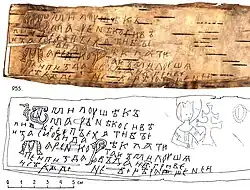сѣкꙑль
Old Novgorodian
Etymology
Inherited from Proto-Slavic *sь̀kyľь (“clitoris; vulva”), from *sьkati, *sikati (“to piss”). All forms of the roots *sьk-, *sik-, *sěk- are ultimately from Proto-Indo-European *seykʷ- (“to moisten”). Cognate with Russian се́киль (sékilʹ), Ukrainian се́кіль (sékilʹ), си́кель (sýkelʹ).

Birchbark letter no. 955 (c. 1140‒1160)
Noun
сѣкꙑль (sěkylĭ) m
Related terms
Old Novgorodian terms derived from the Proto-Indo-European root *seykʷ- (0 c, 1 e)
References
- “сѣкꙑле (letter no. 955), c. 1140‒1160”, in Древнерусские берестяные грамоты [Birchbark Literacy from Medieval Rus] (in Russian), http://gramoty.ru, 2007–2024
Further reading
- Yanin, V. L., Zaliznyak, A. A., Gippius, A. A., editors (2015), “Грамота № 955”, in Новгородские грамоты на бересте (2001–2014 гг.) [Novgorod letters on birchbark: 2001–2014] (in Russian), volume 12, Moscow: LRC Publishing House, →ISBN, page 55
- Zaliznyak, A. A., Yanin, V. L. (2006) “Берестяные грамоты из новгородских раскопок 2005 г.”, in Вопросы языкознания [Topics in the Study of Language] (in Russian), number 3, archive, Moscow: Nauka, →ISSN, pages 3–13
- “сѣкꙑль”, in Берестяные грамоты – Национальный корпус русского языка [Birchbark Letters – Russian National Corpus], https://ruscorpora.ru/, 2003–2024
This article is issued from Wiktionary. The text is licensed under Creative Commons - Attribution - Sharealike. Additional terms may apply for the media files.